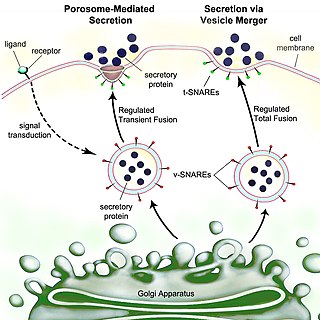Related Research Articles

Bacterial conjugation is the transfer of genetic material between bacterial cells by direct cell-to-cell contact or by a bridge-like connection between two cells. This takes place through a pilus. It is a parasexual mode of reproduction in bacteria.

A pilus is a hair-like appendage found on the surface of many bacteria and archaea. The terms pilus and fimbria can be used interchangeably, although some researchers reserve the term pilus for the appendage required for bacterial conjugation. All conjugative pili are primarily composed of pilin – fibrous proteins, which are oligomeric.

A plasmid is a small, extrachromosomal DNA molecule within a cell that is physically separated from chromosomal DNA and can replicate independently. They are most commonly found as small circular, double-stranded DNA molecules in bacteria; however, plasmids are sometimes present in archaea and eukaryotic organisms. In nature, plasmids often carry genes that benefit the survival of the organism and confer selective advantage such as antibiotic resistance. While chromosomes are large and contain all the essential genetic information for living under normal conditions, plasmids are usually very small and contain only additional genes that may be useful in certain situations or conditions. Artificial plasmids are widely used as vectors in molecular cloning, serving to drive the replication of recombinant DNA sequences within host organisms. In the laboratory, plasmids may be introduced into a cell via transformation. Synthetic plasmids are available for procurement over the internet.

Secretion is the movement of material from one point to another, such as a secreted chemical substance from a cell or gland. In contrast, excretion is the removal of certain substances or waste products from a cell or organism. The classical mechanism of cell secretion is via secretory portals at the plasma membrane called porosomes. Porosomes are permanent cup-shaped lipoprotein structures embedded in the cell membrane, where secretory vesicles transiently dock and fuse to release intra-vesicular contents from the cell.

Agrobacterium radiobacter is the causal agent of crown gall disease in over 140 species of eudicots. It is a rod-shaped, Gram-negative soil bacterium. Symptoms are caused by the insertion of a small segment of DNA, from a plasmid into the plant cell, which is incorporated at a semi-random location into the plant genome. Plant genomes can be engineered by use of Agrobacterium for the delivery of sequences hosted in T-DNA binary vectors.

A tumour inducing (Ti) plasmid is a plasmid found in pathogenic species of Agrobacterium, including A. tumefaciens, A. rhizogenes, A. rubi and A. vitis.
The F-plasmid allows genes to be transferred from one bacterium carrying the factor to another bacterium lacking the factor by conjugation. The F factor was the first plasmid to be discovered. Unlike other plasmids, F factor is constitutive for transfer proteins due to a mutation in the gene finO. The F plasmid belongs to F-like plasmids, a class of conjugative plasmids that control sexual functions of bacteria with a fertility inhibition (Fin) system.
Fosmids are similar to cosmids but are based on the bacterial F-plasmid. The cloning vector is limited, as a host can only contain one fosmid molecule. Fosmids can hold DNA inserts of up to 40 kb in size; often the source of the insert is random genomic DNA. A fosmid library is prepared by extracting the genomic DNA from the target organism and cloning it into the fosmid vector. The ligation mix is then packaged into phage particles and the DNA is transfected into the bacterial host. Bacterial clones propagate the fosmid library. The low copy number offers higher stability than vectors with relatively higher copy numbers, including cosmids. Fosmids may be useful for constructing stable libraries from complex genomes. Fosmids have high structural stability and have been found to maintain human DNA effectively even after 100 generations of bacterial growth. Fosmid clones were used to help assess the accuracy of the Public Human Genome Sequence.
A relaxase is a single-strand DNA transesterase enzyme produced by some prokaryotes and viruses. Relaxases are responsible for site- and strand-specific nicks in unwound double-stranded DNA. Known relaxases belong to the rolling circle replication (RCR) initiator superfamily of enzymes and fall into two broad classes: replicative (Rep) and mobilization (Mob). The nicks produced by Rep relaxases initiate plasmid or virus RCR. Mob relaxases nick at origin of transfer (oriT) to initiate the process of DNA mobilization and transfer known as bacterial conjugation. Relaxases are so named because the single-stranded DNA nick that they catalyze lead to relaxation of helical tension.

Prokaryotic DNA Replication is the process by which a prokaryote duplicates its DNA into another copy that is passed on to daughter cells. Although it is often studied in the model organism E. coli, other bacteria show many similarities. Replication is bi-directional and originates at a single origin of replication (OriC). It consists of three steps: Initiation, elongation, and termination.
An origin of transfer (oriT) is a short sequence ranging from 40-500 base pairs in length that is necessary for the transfer of DNA from a gram-negative bacterial donor to recipient during bacterial conjugation. The transfer of DNA is a critical component for antimicrobial resistance within bacterial cells and the oriT structure and mechanism within plasmid DNA is complementary to its function in bacterial conjugation. The first oriT to be identified and cloned was on the RK2 (IncP) conjugative plasmid, which was done by Guiney and Helinski in 1979.
The relaxosome is the complex of proteins that facilitates plasmid transfer during bacterial conjugation. The proteins are encoded by the tra operon on a fertility plasmid in the region near the origin of transfer, oriT. The most important of these proteins is relaxase, which is responsible for beginning the conjugation process by cutting at the nic site via transesterification. This nicking results in a DNA-Protein complex with the relaxosome bound to a single strand of the plasmid DNA and an exposed 3' hydroxyl group. Relaxase also unwinds the plasmid being conjugated with its helicase properties. The relaxosome interacts with integration host factors within the oriT.
The traA gene codes for relaxase, which is an enzyme that initiates plasmid DNA transfer during bacterial conjugation. Relaxase forms a relaxosome complex with auxiliary proteins to initiate conjugation. Relaxosome binds to the origin of transfer (oriT) sequence and cleaves the DNA strand that will be transferred.
In molecular cloning, a vector is any particle used as a vehicle to artificially carry a foreign nucleic sequence – usually DNA – into another cell, where it can be replicated and/or expressed. A vector containing foreign DNA is termed recombinant DNA. The four major types of vectors are plasmids, viral vectors, cosmids, and artificial chromosomes. Of these, the most commonly used vectors are plasmids. Common to all engineered vectors are an origin of replication, a multicloning site, and a selectable marker.

The traJ-II RNA motif is a conserved RNA structure discovered in bacteria by using bioinformatics. traJ-II RNAs appear to be in the 5' untranslated regions of protein-coding genes called traJ, which functions in the process of bacterial conjugation. A previously identified motif known as TraJ 5' UTR is also found upstream of traJ genes functions as the target of FinP antisense RNAs, so it is possible that traJ-II RNAs play a similar role as targets of an antisense RNA. However, some sequence features within the traJ-II RNA motif suggest that the biological RNA might be transcribed from the reverse-complement strand. Thus is it unclear whether traJ-II function as cis-regulatory elements. traJ-II RNAs are found in a variety of Pseudomonadota.

Plasmid-mediated resistance is the transfer of antibiotic resistance genes which are carried on plasmids. Plasmids possess mechanisms that ensure their independent replication as well as those that regulate their replication number and guarantee stable inheritance during cell division. By the conjugation process, they can stimulate lateral transfer between bacteria from various genera and kingdoms. Numerous plasmids contain addiction-inducing systems that are typically based on toxin-antitoxin factors and capable of killing daughter cells that don't inherit the plasmid during cell division. Plasmids often carry multiple antibiotic resistance genes, contributing to the spread of multidrug-resistance (MDR). Antibiotic resistance mediated by MDR plasmids severely limits the treatment options for the infections caused by Gram-negative bacteria, especially family Enterobacteriaceae. The global spread of MDR plasmids has been enhanced by selective pressure from antimicrobial medications used in medical facilities and when raising animals for food.
The RK2 Plasmid is a broad-host-range plasmid belonging to the incP incompatibility group It is notable for its ability to replicate in a wide variety of single-celled organisms, which makes it suitable as a genetic engineering tool. It is capable of transfer, replication, and maintenance in most genera of Gram-negative bacteria. RK2 may sometimes be referred to as pRK2, which is also the name of another, unrelated plasmid. Other names for RK2 include R18, R68, RP1, and RP4. These were all separate isolates, and later found to be identical plasmids. The IncP-1 plasmid group of which RK2 is a part has been described as "highly potent, self-transmissible, selfish DNA molecules with a complicated regulatory circuit"
A plasmid partition system is a mechanism that ensures the stable inheritance of plasmids during bacterial cell division. Each plasmid has its independent replication system which controls the number of copies of the plasmid in a cell. The higher the copy number, the more likely the two daughter cells will contain the plasmid. Generally, each molecule of plasmid diffuses randomly, so the probability of having a plasmid-less daughter cell is 21−N, where N is the number of copies. For instance, if there are 2 copies of a plasmid in a cell, there is 50% chance of having one plasmid-less daughter cell. However, high-copy number plasmids have a cost for the hosting cell. This metabolic burden is lower for low-copy plasmids, but those have a higher probability of plasmid loss after a few generations. To control vertical transmission of plasmids, in addition to controlled-replication systems, bacterial plasmids use different maintenance strategies, such as multimer resolution systems, post-segregational killing systems, and partition systems.
The bacterial type IV secretion system, also known as the type IV secretion system or the T4SS, is a secretion protein complex found in gram negative bacteria, gram positive bacteria, and archaea. It is able to transport proteins and DNA across the cell membrane. The type IV secretion system is just one of many bacterial secretion systems. Type IV secretion systems are related to conjugation machinery which generally involve a single-step secretion system and the use of a pilus. Type IV secretion systems are used for conjugation, DNA exchange with the extracellular space, and for delivering proteins to target cells. The type IV secretion system is divided into type IVA and type IVB based on genetic ancestry.
Integrative and conjugative elements (ICEs) are mobile genetic elements present in both gram-positive and gram-negative bacteria. In a donor cell, ICEs are located primarily on the chromosome, but have the ability to excise themselves from the genome and transfer to recipient cells via bacterial conjugation.
References
- 1 2 Figurski D, Helinski D (1979). "Replication of an origin-containing derivative of plasmid RK2 dependent on a plasmid function in trans". PNAS. 76 (4): 1648–1652. doi: 10.1073/pnas.76.4.1648 . PMC 383447 . PMID 377280.
- ↑ Fu, Y H; Tsai, M M; Luo, Y N; Deonier, R C (February 1991). "Deletion analysis of the F plasmid oriT locus". Journal of Bacteriology. 173 (3): 1012–1020. doi:10.1128/jb.173.3.1012-1020.1991. ISSN 0021-9193. PMC 207219 . PMID 1991706.
- 1 2 Simon R, Priefer U, Puhler A (1983). "A Broad Host Range Mobilization System for In Vivo Genetic Engineering: Transposon Mutagenesis in Gram Negative Bacteria". Nature Biotechnology. 1 (9): 784–791. doi:10.1038/nbt1183-784. S2CID 46140184.
- 1 2 Clewell D, et al. (1993). Bacterial Conjugation. Plenum Press, New York. ISBN 978-0-306-44376-3.
- ↑ Frankel, Gad; David, Sophia; Low, Wen Wen; Seddon, Chloe; Wong, Joshua L C; Beis, Konstantinos (18 August 2023). "Plasmids pick a bacterial partner before committing to conjugation". Nucleic Acids Research. doi: 10.1093/nar/gkad678 . PMC 10516633 . PMID 37592747.
- ↑ Grohmann E, Muth G, Espinosa M (2003). "Conjugative Plasmid Transfer in Gram-Positive Bacteria". Microbiology and Molecular Biology Reviews. 67 (2): 277–301. doi:10.1128/MMBR.67.2.277-301.2003. PMC 156469 . PMID 12794193.